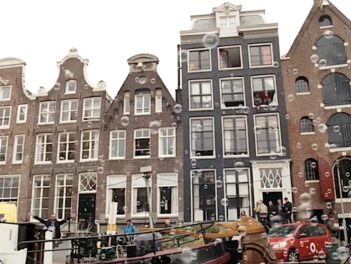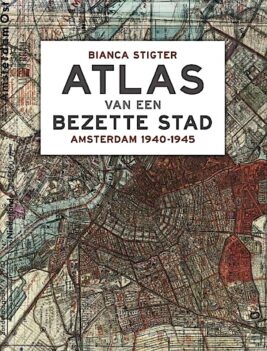By Robert St. Martin
Los Angeles, CA (The Hollywood Times) 1/12/24 – Playing this past week at the Landmark Nuart Theatre in West L.A. is Steve McQueen’s four-and-a-half long documentary ”Occupied City” (UK/Netherlands, 2023) – which tells the stories of Amsterdam during German occupation in World War II from 1940 to 1945, but through the lens of Amsterdam today.
 “Occupied City” is based on the historical research of McQueen’s partner Bianca Stigter, whose “Atlas van een bezette stad: Amsterdam 1940-1945” (2019, available only in Dutch). The film has an entirely different structure from Stigler’s book, which carefully maps out all the buildings and sites street by street in Amsterdam and the history of these places during German occupation, which were once the homes of Jewish people (most of whom were deported to concentration camps in the East) as well as hiding places used to protect Jews and members of the Dutch Resistance. The documentary should be available on Amazon Prime soon.
“Occupied City” is based on the historical research of McQueen’s partner Bianca Stigter, whose “Atlas van een bezette stad: Amsterdam 1940-1945” (2019, available only in Dutch). The film has an entirely different structure from Stigler’s book, which carefully maps out all the buildings and sites street by street in Amsterdam and the history of these places during German occupation, which were once the homes of Jewish people (most of whom were deported to concentration camps in the East) as well as hiding places used to protect Jews and members of the Dutch Resistance. The documentary should be available on Amazon Prime soon.
What marks this long film as unusual is the outlay of historical past on the present footprint of the city of Amsterdam. For the most part, Amsterdam was not bombed during World War II because, unlike the port city of Rotterdam, it had little strategic value. Hence, many of the buildings of Amsterdam and its many squares still remain as haunted reminders of what happened to the people of this city during those war years.

McQueen provides us with a seemingly endless series of shots of contemporary life in the city while a voiceover by Melanie Hyams intones about historical events that took place at each spot. We all walk in the shadows of what came before, but in the city of Amsterdam, where McQueen and his wife and creative partner Bianca have lived for many years, the recent past was a particularly heinous episode.
Every film is a collection of moving images, but few are as moving as the sights that compose ”Occupied City” . Filmed during the outset of the COVID pandemic, when, like many cities around the globe, Amsterdam turned to facemasks, social distancing, and quarantines to stem the virus’ tide, McQueen recorded the difficult remnants and former sites from the Nazi occupation of the city during World War II.

On its face, the director’s blending of the pandemic and the last world war conflict is logical: After all, these are two seismic events that lead to incalculable loss. But McQueen opts for less of a parallel, and more of a juxtaposition between how the city’s past and present inhabitants reacted to their respective horrific circumstances. “Occupied City” . therefore, is a chilling survey of how history’s repeating coil resides in unsuspecting places.
McQueen’s approach, in length and substance, is different from this year’s other Holocaust related films like “The Zone of Interest” or “Origin” McQueen doesn’t aim to achieve an arresting horror or to explain one person’s grief. This urban interrogation is historical – a frank interplay between survival and oblivion, selflessness and selfishness, continuity and demolition.

The film is split into two feature-length halves, with a 15-minute intermission in between: The first half more closely compares the difficulty of the pandemic to the hardships of occupation, while the second section recalls the many forms of resistance carried out during the war (though, to be sure, both subjects do, from time to time, intermingle no matter the half).
With a calm and undemonstrative narrative voiceover from Melanie Hyams, the film tracks day-to-day life in Amsterdam under Nazi rule. It spans the invasion in 1940; the establishment of the NSB, the collaborationist Dutch Nazi party; the increasingly brutal repression and deportation of Jewish populations to the death camps; and then the “hunger winter” of 1944 to 1945 as food and fuel became scarce in the city and the Nazis displayed a gruesome mix of panic and fanaticism as the allies closed in.

“Occupied City” visits former homes, once owned by the Resistance, now possessed by new inhabitants. It ventures through public spaces – squares and parks, docks and canals – where murder was either decided or carried out. It leaps from schools, to hospitals, train stations, and the former offices that formed the connective web of mass extermination. Tours through nightclubs, concert halls, and museums recall the Nazi’s censorship of art, from the erasure of Jewish painters and composers to the banning of dance and music, particularly songs containing “Negro elements.”
Because of the dense, meditative nature of ”Occupied City” , it almost impossible to summarize. The stories shared, sometimes from viciously antisemitic journals written by key eyewitnesses and books written by survivors, are not necessarily in chronological order. There are also no talking heads or even a map for viewers not from Amsterdam to get a sense of how these sites geographically communicate.

Instead, McQueen’s film is an unceasing stream of tragedies, achieving a cumulative power meant to mirror the sense of unending dread that must have hung over the city. What is most enduring, however, are the stories of real resistance. How many Jewish people chose to wield their own destinies through suicide? How many Jewish people passed as gentiles to then save friends, relatives, and anyone else they could find? How many Dutch citizens hid close neighbors and complete strangers?
At one point, Hyams shares the story of a Jewish man, who, having never flown a seaplane before, commandeered a German one covered with Swastikas, and transported his family to the safety of England.
 The filmmaker has the vital sense to know when to let the images speak for themselves. When Hyams shares details about the curfew instituted by Germany during the war, McQueen allows for her voice to fall away; with a precisely controlled track, the cinematographer Lennert Hillege’s lens drifts above the contemporary nighttime streets, tilting and turning over, gliding past sleepy storefronts and glowing street lights as composer Oliver Coates’ wheezing, melancholic score, punctuated by backwards pulses whose repetitions are akin to mournful sighs, soundtracks the city’s eerie emptiness.
The filmmaker has the vital sense to know when to let the images speak for themselves. When Hyams shares details about the curfew instituted by Germany during the war, McQueen allows for her voice to fall away; with a precisely controlled track, the cinematographer Lennert Hillege’s lens drifts above the contemporary nighttime streets, tilting and turning over, gliding past sleepy storefronts and glowing street lights as composer Oliver Coates’ wheezing, melancholic score, punctuated by backwards pulses whose repetitions are akin to mournful sighs, soundtracks the city’s eerie emptiness.
 The filmmaker takes aim at the local Dutch police force, who, without a hint of irony, use a drone to record the participants of an anti-Fascist rally. He also connects the present monarchy to the country’s imperialist past, its retention of the then named Dutch West Indies (located in the Caribbean) and the current colonies they still possess.
The filmmaker takes aim at the local Dutch police force, who, without a hint of irony, use a drone to record the participants of an anti-Fascist rally. He also connects the present monarchy to the country’s imperialist past, its retention of the then named Dutch West Indies (located in the Caribbean) and the current colonies they still possess.
While the word “demolished” is often uttered by the narrator Hyams to denote a building’s disappearance, becoming a debilitating blow to the listener, the word also reminds viewers of how easily the markers of history can disappear. The word “demolished” itself becomes a form of witnessing. Because despite those sites not wholly existing anymore, what has been seen cannot be unseen. And while that solace is only half the desire, the harrowing stories that McQueen’s ”Occupied City” delivers to viewers, stories meticulously bound together by Stigter’s research, are the other half of the film’s memorializing that will live on.




